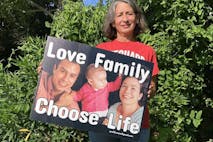
Fact Check: Woman says she was denied treatment as baby 'poisoned her from inside out'
Nancy Flanders
·
“1 in 3 women has had an abortion” claim gets four Pinocchios
Washington Post writer Michelle Ye Hee Lee, who previously debunked Planned Parenthood’s claim that abortions make up only three percent of their services, has just debunked another pro-abortion myth: that one in three women has had an abortion.
An earlier fact check of a similar claim made by abortion advocates — that one in three women (or one-third) will have an abortion by age 45 — received two Pinocchios from the Washington Post. This hasn’t stopped Planned Parenthood or others in the abortion industry from making the claim. In fact, Planned Parenthood not only makes this claim on their “Abortion Services” web page, but also links to the 1in3campaign.org website — a site which claims at the very top of its home page: “1 in 3 women will have an abortion in her lifetime.” (Indeed, this is the entire theme of the site.) The website was created by Advocates for Youth, a Planned Parenthood partner.
For her latest fact check, Lee takes on a letter from NARAL Pro-Choice America and other pro-abortion groups. In this letter, the groups make the claim that one in three women has had an abortion. Lee says the data relied upon to make this erroneous claim was gathered from 9,500 women in 2008 — nearly a decade ago. The Guttmacher Institute (originally formed as Planned Parenthood’s research arm) released a study in 2011 that was based on this data.
Lee writes:
Researchers used survey data to find the first abortion rate for age subgroups, multiplied the rate by the number of years in each age group, and added up the number of first-time abortions that had taken place by the time women were 45 years old. This was called the “cumulative first abortion rate,” through which they came up with the “lifetime incidence” of abortion, or the “one in three” figure.
The study found that 30 percent of women (effectively, one in three) would have an abortion by age 45, if the 2008 abortion rate prevailed.
The problem is, no one knows if, in fact, this abortion rate prevailed. It is based on a projection, admitted Guttmacher spokesperson Rebecca Wind. “At the time those data were published,” she told Lee, “it was an accurate statement to say that one in three women would have an abortion by age 45 (not has had an abortion, it’s a projection by the end of their reproductive years),” but, “… at the moment, there is no current data to support that statement.”
Lee points to more recent data from the Centers for Disease Control to show it is quite possible that the claim of “one in three” may need to be revised:
Article continues below
Dear Reader,
In 2026, Live Action is heading straight where the battle is fiercest: college campuses.
We have a bold initiative to establish 100 Live Action campus chapters within the next year, and your partnership will make it a success!
Your support today will help train and equip young leaders, bring Live Action’s educational content into academic environments, host on-campus events and debates, and empower students to challenge the pro-abortion status quo with truth and compassion.
Invest in pro-life grassroots outreach and cultural formation with your QUADRUPLED year-end gift!
The latest national abortion data from the Centers for Disease Control and Prevention are from 2012, when there were 699,202 legal induced abortions reported from 49 reporting areas. The abortion rate was 13.2 per 1,000 women aged 15 to 44 years. Census data show there were 62.3 million women aged 15 to 45 in 2012. One-third of that is 20.6 million women. These numbers show the claim in this letter is not correct.
Lee notes that Guttmacher is currently working on updated information using the results of their 2014 Abortion Patient Survey, writing, “Without the breakdown of first-time abortions of women ages 15 to 44 in 2014,” there is no way to tell how the statistic would change, but “previous trends indicate it could decrease.”
Lee arrives at the conclusion that the abortion industry’s claim that one in three women has had an abortion “is unsupported by facts and earns Four Pinocchios.”
But that doesn’t really matter to NARAL Pro-Choice America spokesperson Kaylie Hanson Long, who also admitted that the “one in three women has had an abortion” claim was “presumed.” But, she said, it shouldn’t matter whether the claim is false because “abortion is a common medical procedure…that must be respected and available, given there’s a clear need for it for so many women in this country.”
In other words, even if the claim is not factual, abortion advocates will continue to use it to push their preferred narrative that abortion is extremely common among women. (Could this be because organizations who profit from abortion — like Planned Parenthood — want to see abortions become more “plentiful”?)
At the same time Planned Parenthood and friends continue to point to the prevalence of abortion, the nation’s largest abortion chain also wants to insist they barely focus on helping those “one in three” women obtain an abortion. However, Planned Parenthood’s oft-repeated claim that abortion makes up just three percent of their services has been debunked — not only by the Washington Post, but also by Live Action:

Live Action News is pro-life news and commentary from a pro-life perspective.
Contact editor@liveaction.org for questions, corrections, or if you are seeking permission to reprint any Live Action News content.
Guest Articles: To submit a guest article to Live Action News, email editor@liveaction.org with an attached Word document of 800-1000 words. Please also attach any photos relevant to your submission if applicable. If your submission is accepted for publication, you will be notified within three weeks. Guest articles are not compensated (see our Open License Agreement). Thank you for your interest in Live Action News!

Nancy Flanders
·
Analysis
Nancy Flanders
·
Fact Checks
Nancy Flanders
·
Fact Checks
Nancy Flanders
·
Fact Checks
Cassy Cooke
·
Fact Checks
Madison Evans
·
Media
Kelli Keane
·
Human Interest
Kelli Keane
·
Activism
Kelli Keane
·
Politics
Kelli Keane
·
Human Interest
Kelli Keane
·